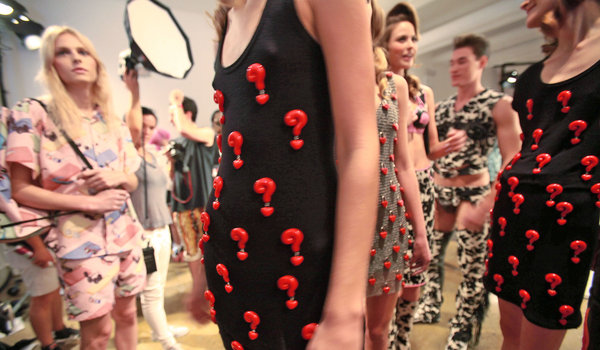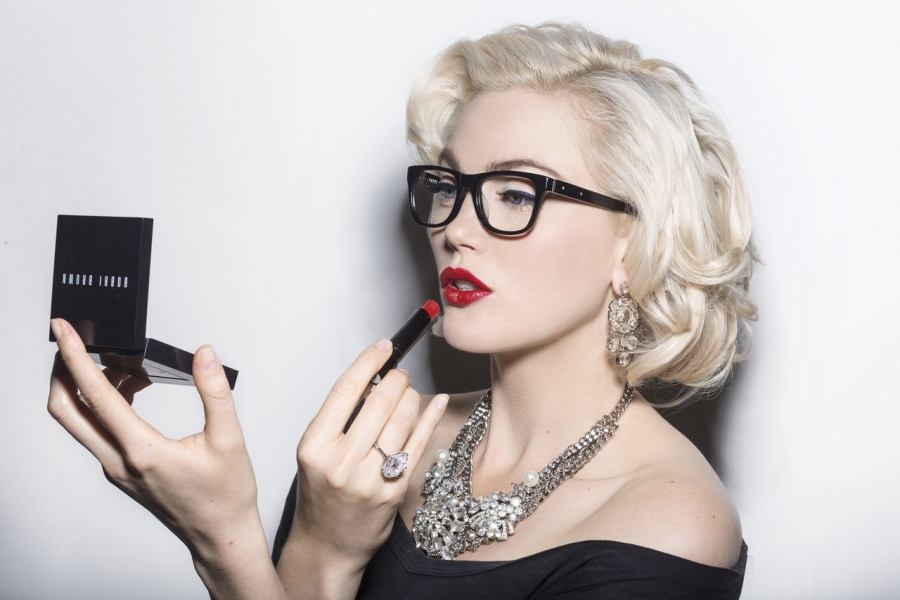|
Checking models' ID at the door.
Posted on: 02/09/12
Designers and modeling agencies have pledged not to cast girls under 16 in the shows.  IN the five years since fashion designers got serious about protecting the health and well-being of young models, there has been a measurable improvement in the prevailing ideal of beauty as seen on the runways. Many of the top models working today, like Lara Stone, Joan Smalls and Arizona Muse, reflect a changing aesthetic toward healthier figures and at least some representation of diversity in race and age. And yet, season after season, we still see models who appear to be dangerously thin or, here at the beginning of another New York Fashion Week, models who are as young as 14, even though designers and modeling agencies have pledged not to cast girls younger than 16 in the shows. If you believe them. Assessing the impact of a campaign to curb reckless behavior in their industry, Diane Von Furstenberg, the president of the Council of Fashion Designers of America, said this week that some progress had been made but that much work remained to be done. This season, the council urged its members to insist on seeing identification from models to prove that they are 16 by the time of their shows. (Ms. Von Furstenberg herself was embarrassed a year ago, when, after promoting the age requirement, it was discovered that one of the models in her own show was still 15.) “If we haven’t done anything else,” Ms. Von Furstenberg said, measuring her words, “we certainly have created awareness.” Steven Kolb, the chief executive of the fashion council, noted that in addition to its publicly announced guidelines, designers have met behind the scenes with agents, casting directors and models to promote healthy behavior. Guidelines include educating the industry to recognize the early signs of eating disorders, supplying healthy snacks backstage and not allowing models under 18 to work past midnight at fittings or photo shoots. Nevertheless, when asked to grade the industry’s performance, he replied, “I’m going to give us a ‘B.’ ” Concerns about fashion models, especially after the anorexia-related death of Ana Carolina Reston, a South American model, in 2006, prompted considerable debate about their weight (too thin), their skin color (too white) and, more recently, their age (too young). Organizers of shows in Madrid and Milan, facing consumer backlash and scrutiny by European legislators, initiated outright bans of models who were seen as dangerously skinny, based on some form of objective measurement, like a height-to-weight ratio. But American designers rejected that option as unrealistic and unworkable, since few models, because of their height, would meet standards seen as normal by health organizations. Their decision to promote guidelines, however, was criticized by some nutritionists and eating-disorder specialists as an ineffectual response. Five years after the industry first took that position, even some of the most vocal critics of the council now acknowledge that American designers, through their outreach, have perhaps played a greater role in combating eating disorders among models than the weight rules in Europe have. Madrid, where rules are strictly enforced, plays a small role in international fashion. In Milan, there is very little evidence that rules, which many designers have found confusing, have been followed at all. On Monday, the National Eating Disorders Association released a statement thanking the C.F.D.A. for updating its guidelines to include clearer language on education and for checking models’ identification. The original guidelines, said Lynn Grefe, the president of the eating disorders group, “felt like a publicity stunt and did not reflect the concerns we had.” “For whatever reason, five years later, they are addressing this,” Ms. Grefe said. “They are paying more attention to these minors.” The C.F.D.A., in its health initiative guidelines, states that while designers share a responsibility to protect models, they are “not policing.” Mr. Kolb said that a major goal was to move beyond the finger-pointing that has taken place between designers and agents, but that some suspicions clearly remain when cases of underage models arise. “Over all, the industry has responded positively, but there are always going to be people who go against the grain,” Mr. Kolb said. Last September, the model Valerija Sestic, discovered in Croatia, appeared in several New York shows even though she was then under 16. Her agents at Women Management apologized after designers complained they had been misled.The reason models should be 16, the council argues, is that they are more likely to have the maturity to deal with being rejected by designers or treated disrespectfully by photographers. Of major concern are those who take pictures of models when they are undressed backstage. At least a dozen agencies, including Women, have pledged not to send underage models to designers this season, and yet some designers remain skeptical. Ford Models includes the hot newcomer Ondria Hardin in its show package, the portfolio of models it presents to casting agents, even though Ms. Hardin was reported to be 14 when she appeared in the Marc Jacobs show last season. Paul Rowland, her agent, did not respond to messages regarding Ms. Hardin and another reportedly underage model currently promoted by Ford. “It is a good example to follow,” said Faith Kates, the founder of Next Models, which represents top models like Ms. Muse, Karlie Kloss and Abbey Lee Kershaw. “I just hope everyone will follow it.” This week, the designer Tory Burch began looking at models for her Feb. 14 show. At least 75 young women came through her office, some of whom caused her concern. “There is still an issue, and there is still a lot of work to be done,” Ms. Burch said. “There have been positive steps. But I see some girls coming in who are really emaciated. It is still a problem.” Tommy Hilfiger said he also continues to see models who are too young or too thin. “Eventually, I would like to see models become licensed and registered,” he said. For decades, there have been efforts to unionize models, but because of the short-term nature of most careers, there has been little movement. After two years of planning, Sara Ziff, a former runway model, started a new group this week called the Model Alliance, an advocacy group that seeks to empower models. Ms. Ziff said that problems in the industry, like violation of child labor laws, lack of financial transparency and sexual abuse, extend far beyond Fashion Week. In conjunction with Actors’ Equity and the American Guild of Musical Artists, Model Alliance has formed a grievance reporting system as one of its first initiatives. “Right now the fashion industry is policing itself,” Ms. Ziff said. “The industry, for whatever reason, is resistant to change.” COMMENTS
Be the first to post a comment! Post A Comment:

|
.gif)



.jpg)

